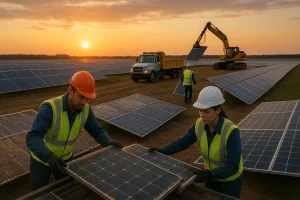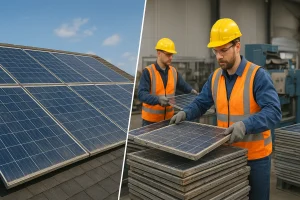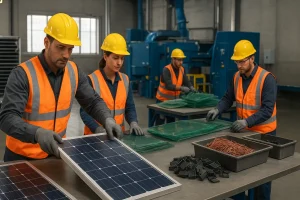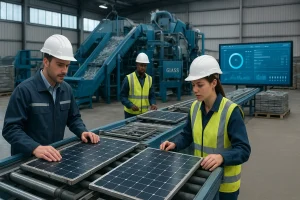Solar Panel Recycling: What Happens When Panels Reach End of Life?

What Really Happens to Solar Panels at the End of Their Life?
The solar energy industry experiences unprecedented growth across the United States. Installations reach new heights every quarter. However, the first generation of solar panels installed in the early 2000s approaches their 25-30 year operational lifespan. Consequently, a critical challenge emerges: what happens to solar panels when they reach end of life?

For US solar installers and EPCs, understanding solar panel recycling processes matters greatly. Furthermore, grasping regulations and business opportunities isn’t just about environmental responsibility. Instead, it’s becoming a competitive necessity that drives new revenue streams. Additionally, it ensures sustainable business practices.
The Growing Need for Solar Panel End-of-Life Management
By 2030, the United States will generate one million total tons of solar panel waste. Moreover, this represents a significant portion of the global end-of-life photovoltaic market. According to market research, 25-30% of solar modules will reach their end-of-life by 2030. Therefore, this creates an urgent need for comprehensive recycling solutions.
Understanding Solar Panel Lifespan and Degradation
Most manufacturers guarantee solar panels to produce 80% of their original labeled rate after 25 years. However, the reality of end-of-life solar panels involves two primary scenarios:

Early Loss Scenario: In 2024, the Early Loss segment captured more than 63.20% of the solar panel recycling market share. This scenario addresses panels that fail before reaching their expected lifespan. Typically, manufacturing defects, installation damage, or severe weather conditions cause early failure.
Regular Loss Scenario: These panels complete their operational lifecycle successfully. Subsequently, they experience gradual degradation over 25-30 years. Eventually, they require replacement or solar panel disposal.
Current US Regulations and State Requirements
Federal Framework
Federal solid and hazardous waste regulations apply to solar panels when discarded. Specifically, the Resource Conservation and Recovery Act (RCRA) governs disposal. The critical factor determines whether panels meet the toxicity characteristic. Heavy metals like lead and cadmium trigger this classification.
Currently, EPA plans to propose new rules to improve end-of-life solar panel management. Furthermore, they will add hazardous waste solar panels to universal waste regulations. As a result, this will streamline handling requirements for installers and EPCs.
State-Level Developments
Several states lead solar waste management initiatives:
California: Starting January 1, 2021, California regulates decommissioned solar panels like other universal wastes. Consequently, this makes collection, processing, and recycling less expensive and burdensome.
Washington State: Washington implements comprehensive solar panel waste regulations. Additionally, they provide specific dangerous waste requirements and recycling options.
New York: DEC considers adding solar panels to the Universal Waste rule. Therefore, this will streamline collection and recycling of hazardous waste.
Georgia: In 2024, Georgia introduced new regulations through House Bill 300. Moreover, this creates a structured framework for decommissioning solar panels.
The Recycling Process: From Collection to New Products
Material Recovery and Value
Glass composes most of the weight of a solar panel (about 75 percent). Fortunately, glass recycling already operates as a well-established industry. Other easily recyclable components include aluminum frames, copper wiring, and plastic junction boxes.

Advanced recycling facilities achieve impressive recovery rates. For example, SOLARCYCLE’s next generation recycling process recovers up to 99% of PV materials. Additionally, it optimizes specifically for bifacial C-Si panels.
Recycling Technologies
Mechanical Recycling: The Mechanical process held a strong market position in 2024. Specifically, it secured over 39.20% of the industry share. This process involves physical separation without chemicals. Therefore, it remains environmentally friendly and scalable.
Thermal and Chemical Processes: Companies use these for more complex material separation. Additionally, they recover high-value components like silver and silicon.
Laser Technology: The laser segment will grow at a CAGR of 9.8% from 2025 to 2030. This growth stems from increasing demand for advanced and efficient recycling methods.
Market Opportunities for Solar Installers and EPCs

Revenue Potential
According to the International Renewable Energy Agency, recoverable raw materials from end-of-life panels will be worth $450 million globally by 2030. This represents significant opportunity for forward-thinking installers and EPCs. Consequently, they can develop solar panel recycling services.
Industry Growth Projections
Analysts estimated the global solar panel recycling market at USD 322.9 million in 2024. Furthermore, they project it will reach USD 548.0 million by 2030. This represents a CAGR of 7.4%. Similarly, the United States solar panel recycling market will surge with a CAGR of 12.98%. Additionally, it will reach $90.13 million by 2030.
Case Study: SOLARCYCLE’s Georgia Facility
SOLARCYCLE announced a 5 gigawatt recycling facility in Cedartown Georgia. The facility will recycle materials from 10 million solar panels per year. Furthermore, this capacity can process 25-30% of the U.S.’s retired solar panels in 2030. Initially, the facility will recycle 2 million solar panels per year. Then, it will scale as the company meets growing market demand.
This demonstrates the scale of infrastructure developers create to handle photovoltaic waste management. Moreover, it presents partnership opportunities for installers and EPCs nationwide.
Best Practices for Solar Installers and EPCs
Developing End-of-Life Strategies
- Assessment and Planning: Develop comprehensive solar panel disposal plans during initial project planning phases.
- Partnership Development: Establish relationships with certified recycling facilities and waste management companies.
- Customer Education: Inform clients about end-of-life options and responsibilities during system sales.
- Regulatory Compliance: Stay updated on evolving state and federal regulations for solar waste management.
Creating New Service Lines
Forward-thinking companies develop:
- Decommissioning services
- Recycling coordination programs
- Refurbishment and resale operations
- Reverse logistics solutions
Environmental and Economic Benefits
Environmental Impact: Proper solar panel recycling prevents toxic materials from entering landfills. Additionally, it recovers valuable materials like silver, silicon, and aluminum for reuse.
Economic Advantages: Diverting solar panels from landfills to recycling saves space in landfills. Furthermore, it captures the value of the raw materials.
Looking Ahead: Future Trends and Opportunities
The end-of-life solar panels market will continue expanding as early installations reach retirement age. Key trends include:

- Increased state-level regulations requiring recycling plans
- Growing demand for domestic solar manufacturing using recycled materials
- Development of regional recycling hubs and processing facilities
- Integration of recycling considerations into project financing and planning
Conclusion: How Energyscape Renewables Supports Your Solar Recycling Needs
As the solar industry matures, solar panel recycling becomes essential for sustainable business operations. At Energyscape Renewables, we understand that US solar installers and EPCs need comprehensive support for end-of-life panel management.
Our team provides expert guidance on regulatory compliance and recycling partnerships. Additionally, we help develop sustainable solar waste management strategies that protect your business. Moreover, these strategies create new revenue opportunities.
Whether you’re planning large-scale decommissioning projects or need advice on incorporating recycling considerations into current installations, Energyscape Renewables offers the expertise you need. Furthermore, we provide industry connections to help you navigate this evolving landscape successfully.
Ready to learn more about emerging solar technologies and sustainability practices? Visit Sunscape Solar for additional resources and industry insights. These resources can help grow your solar business while contributing to a more sustainable energy future.

sjayakanth@energyscaperenewables.com